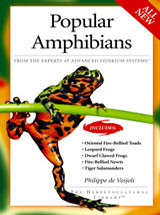Identify the signs of toxicity in your amphibians and tips on keeping the toxicity levels of their water low.
 |
Frogs and salamanders absorb water through their skin and urinary bladders. If the water contains high concentrations of ammonia or other toxins, frogs and salamanders will display signs of poisoning from toxins, or “toxing out.” The signs of toxing out begin with hyperactivity, followed by lethargy in frogs, spastic extensions of the hind legs, and sometimes cloudy eyes.
These frogs and salamanders eventually become listless and die, usually in a matter of a few days. As soon as the signs of toxing out are noted, replace the water. With semiterrestrial amphibians, such as floating frogs, fire-bellied toads or newts, place the affected amphibians in shallow water (half the body height when at rest) in a separate container (a plastic storage box).
This practice is important because toxed-out frogs and salamanders might be too weakened to move and may drown. Replace the water twice daily until improvement is noted, then return the animals to a setup with proper conditions. Toxing out can also occur if terrestrial frogs or salamanders absorb toxins from moist soil. Treatment is the same, except that the substrate in the terrarium will have to be replaced during treatment. A sign of fouled substrate is a bad smell, either a strong ammonia smell or simply a foul odor from decomposition or a buildup of fecal waste.

